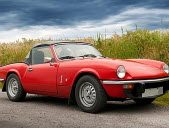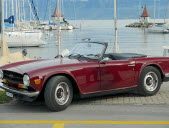Brand stories. Triumph Engine; glory with the roadsters then assisted suicide
The brand was born in 1885 under the name of S. Bettmann & Co. It was founded by Siegfried Bettmann, a German based in London who markets bicycles that he imports from mainland Europe.
The name Triumph was registered in 1886 by Sigfried Bettmann; he wanted the name to be easily pronounceable in German, English and French. Two years later Triumph began manufacturing bicycles in Coventry, then continued to manufacture motorcycles from 1902.
This part of Triumph will experience financial difficulties due to the financial crash of Wall Street in 1929 and will be sold in 1936; Triumph motorcycles still exist.
The logo adopted in 1950 that will be found on the grille of the Triumph Herald. Photo RD
The TCP, the first British production car equipped with hydraulic brakes, was presented in 1925. In 1933, new management took over the reins of Triumph.
He will create a range of cars (sedan, roadster and sport) very well equipped around the Gloria, but sales do not follow. In 1936, it was the turn of the Dolomite, a small roadster, to arrive; 140 hp engine, top speed of 200 km/h but its price was too high for the time.
After the sale of the motorcycle division in 1936, the finances are still in the red and Triumph passes under administrative control in the summer of 1939. In 1945, the factories destroyed by the bombings, Triumph only has to rebuild.
Going through standardization
The future of Triumph goes through a new owner; John Black, already head of Standard automobiles, began by producing an 1800 sedan and then a roadster which did not find their customers.
In 1949, to standardize production, the Triumphs received engines and transmissions from Standard; in 1950, the sedan recovered the chassis of the Vanguard to become the Triumph Renown.
That year, at the Earl’s Court show, Triumph presented a prototype sports car with a Standard engine fitted with overdrive, retractable headlights and an electrically opening bonnet. Too futuristic, it was abandoned after two copies.

Based on the same chassis as the Herald, the Spitfire is a more economical version of the British roadster. Photo RD
In 1952, a simpler prototype (called TR1) gave birth to Triumph’s greatest commercial success: the TR line – for Triumph roadster – which represents more than 200,000 units sold.
The TR2, which arrives shortly after, reaches 170 km/h with its 90 hp 2-litre. In 1956 it was the TR3 with front disc brakes. We have to wait until 1961 to see the TR4; it is designed by Italian Michelotti and fitted with a larger 2.2L engine and a fully synchronized gearbox.
Finally, the TR4 becomes TR4 A IRS with the adoption of an independent rear suspension.
The first sedan for 30 years
Triumph benefited from many orders while Standard vegetated because of unsuitable products. The Standard-Triumph group is investing 2 million pounds for a new sedan project under the Triumph brand.
This will be the Triumph Herald, also designed by Michelotti. Available as a coupé and a 4-seater convertible, it is appreciated despite sometimes erratic behaviour; it stops in 1971. Triumph will use the chassis to produce a more rustic roadster than the TR4: the Spitfire; it will start in 1.1 l to go to 1.3 (75 hp) and finish in 1.5 l. A Spitfire with a 6-cylinder 2-litre engine and a wishbone rear suspension made its appearance in 1966: the GT6.

Certainly the most desirable model in the series, the TR6 is the last real car signed Triumph. Photo RD
In 1961 Triumph was taken over by Leyland Motor Corporation which discontinued the Standard brand. In addition to the roadsters and the Herald, Leyland added the 2000 saloon. In 1968, Leyland merged with BMC and Triumph found itself competing with MG and Rover.
In 1969, Triumph presented the last true TR, the TR6 designed by Karmann. At that time, the USA absorbed up to 75% of production, but new anti-pollution and passive safety standards led the brand to offer a new car fitted with a fixed roof: the TR7, which would be followed by a TR8 with engine. V8 Rover.
Triumph resumes the name of Dolomite, after the small roadster of 1936. This time, it is a sedan which will have a sportier derivative under the name of Dolomite Sprint with 127 hp. Photo RD
In 1970, Triumph released a final sedan, the Dolomite, available in a sporty 127 hp version: the Dolomite Sprint. British Leyland’s biggest problem (following the merger between Leyland and British Motors Corporation) lies in the fact that its activities are based on exporting to the USA, which has just tightened its standards.
British Leyland tried to survive by adapting the Honda Ballade which became the last car to bear the Triumph name in 1981: the Triumph Acclaim. Despite excellent sales, the adventure ended in 1984; The triumph disappears.
